Comprehensive Analysis of Japanese Business Culture and Practices
VerifiedAdded on 2020/04/15
|16
|4404
|706
Report
AI Summary
This report provides a comprehensive analysis of Japanese business culture, focusing on its historical context, cultural nuances, and practical implications for business professionals. It begins with an overview of Japan, highlighting its industrial significance and economic evolution. The report then delves into the diverse and rich Japanese culture, examining family structures, social customs, and subcultures. Furthermore, it explores the seven key aesthetics that shape Japanese sensibilities. A significant portion of the report is dedicated to the business culture, including hiring practices, relationship-oriented approaches, meeting etiquette, business card protocols, and dress codes. The report emphasizes the importance of understanding these cultural aspects for successful business interactions in Japan.
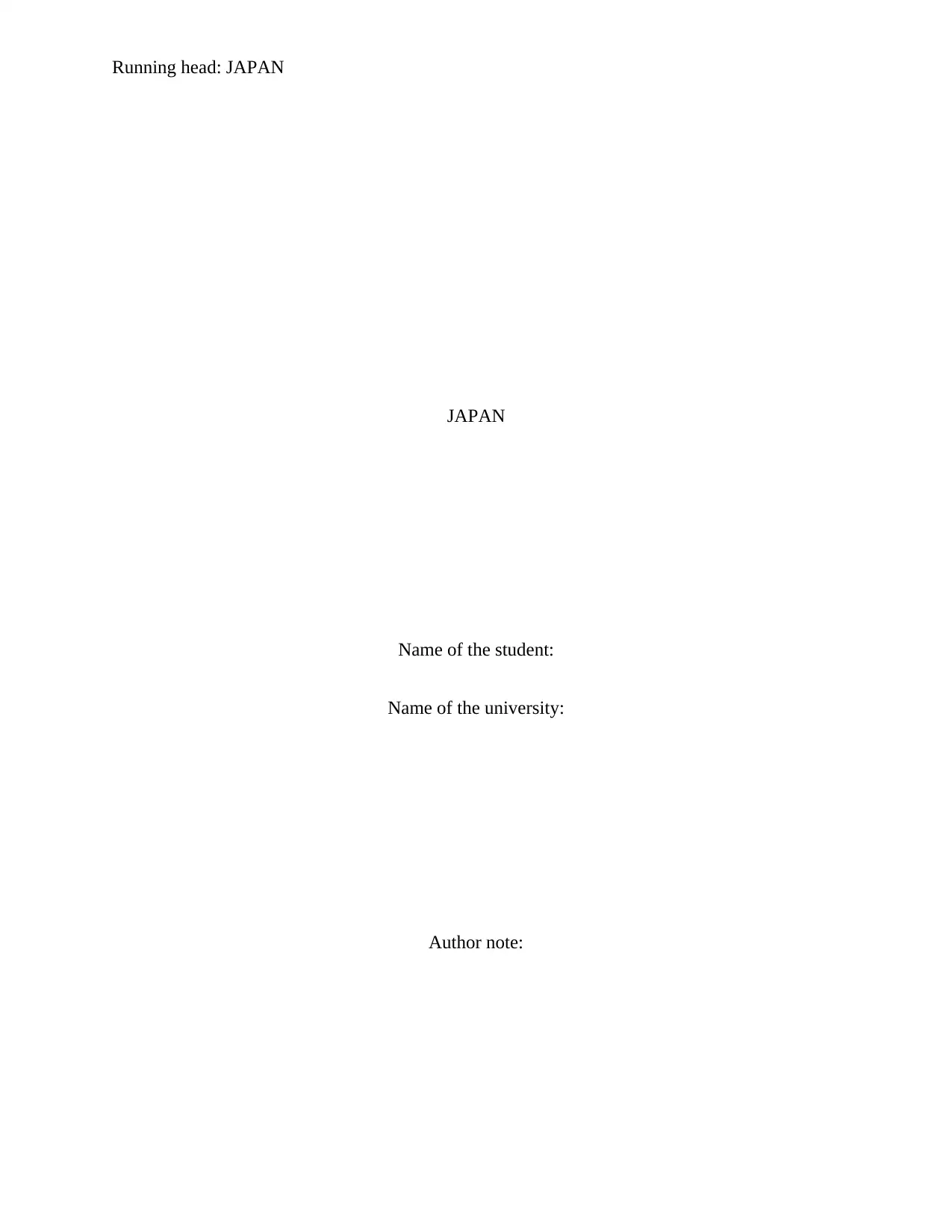
Running head: JAPAN
JAPAN
Name of the student:
Name of the university:
Author note:
JAPAN
Name of the student:
Name of the university:
Author note:
Paraphrase This Document
Need a fresh take? Get an instant paraphrase of this document with our AI Paraphraser
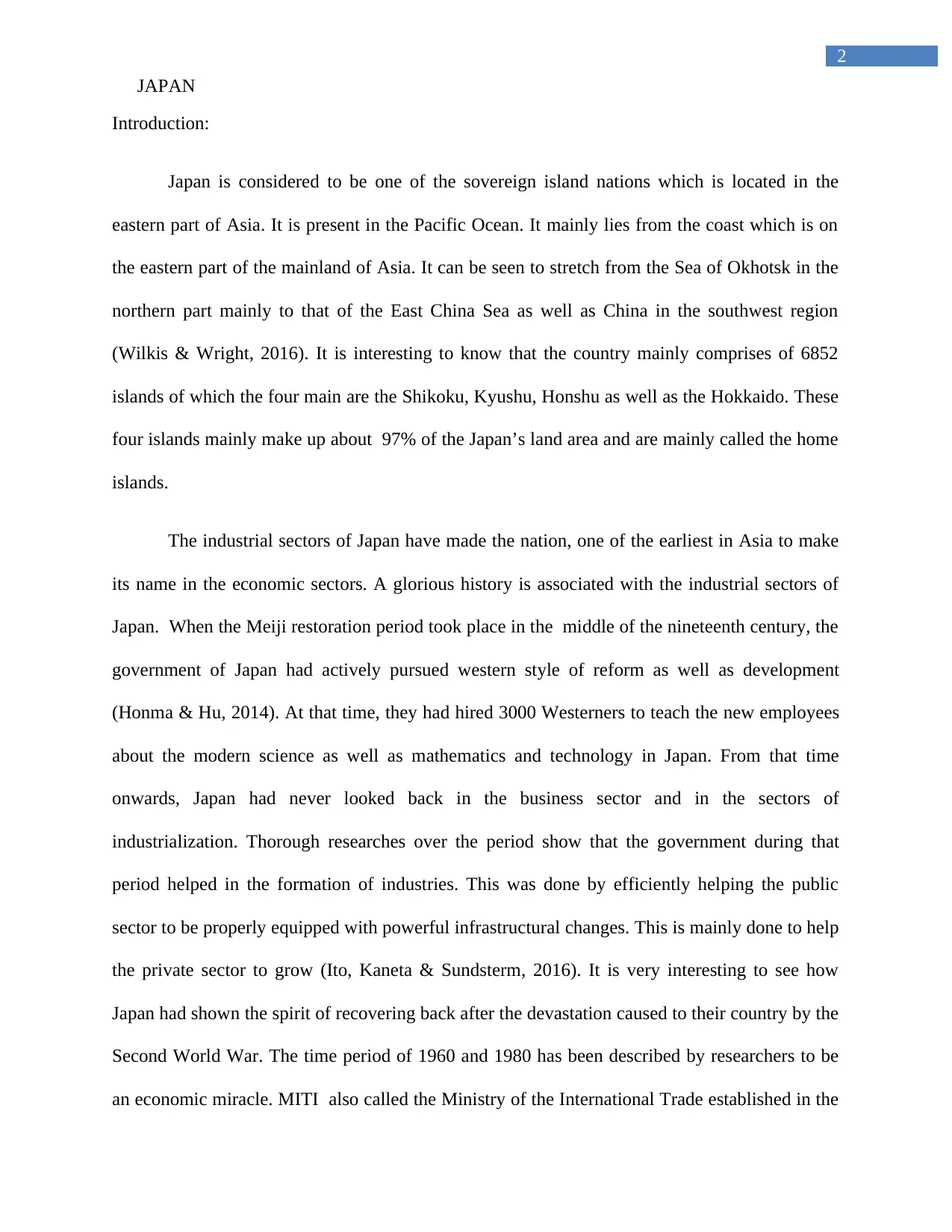
2
JAPAN
Introduction:
Japan is considered to be one of the sovereign island nations which is located in the
eastern part of Asia. It is present in the Pacific Ocean. It mainly lies from the coast which is on
the eastern part of the mainland of Asia. It can be seen to stretch from the Sea of Okhotsk in the
northern part mainly to that of the East China Sea as well as China in the southwest region
(Wilkis & Wright, 2016). It is interesting to know that the country mainly comprises of 6852
islands of which the four main are the Shikoku, Kyushu, Honshu as well as the Hokkaido. These
four islands mainly make up about 97% of the Japan’s land area and are mainly called the home
islands.
The industrial sectors of Japan have made the nation, one of the earliest in Asia to make
its name in the economic sectors. A glorious history is associated with the industrial sectors of
Japan. When the Meiji restoration period took place in the middle of the nineteenth century, the
government of Japan had actively pursued western style of reform as well as development
(Honma & Hu, 2014). At that time, they had hired 3000 Westerners to teach the new employees
about the modern science as well as mathematics and technology in Japan. From that time
onwards, Japan had never looked back in the business sector and in the sectors of
industrialization. Thorough researches over the period show that the government during that
period helped in the formation of industries. This was done by efficiently helping the public
sector to be properly equipped with powerful infrastructural changes. This is mainly done to help
the private sector to grow (Ito, Kaneta & Sundsterm, 2016). It is very interesting to see how
Japan had shown the spirit of recovering back after the devastation caused to their country by the
Second World War. The time period of 1960 and 1980 has been described by researchers to be
an economic miracle. MITI also called the Ministry of the International Trade established in the
JAPAN
Introduction:
Japan is considered to be one of the sovereign island nations which is located in the
eastern part of Asia. It is present in the Pacific Ocean. It mainly lies from the coast which is on
the eastern part of the mainland of Asia. It can be seen to stretch from the Sea of Okhotsk in the
northern part mainly to that of the East China Sea as well as China in the southwest region
(Wilkis & Wright, 2016). It is interesting to know that the country mainly comprises of 6852
islands of which the four main are the Shikoku, Kyushu, Honshu as well as the Hokkaido. These
four islands mainly make up about 97% of the Japan’s land area and are mainly called the home
islands.
The industrial sectors of Japan have made the nation, one of the earliest in Asia to make
its name in the economic sectors. A glorious history is associated with the industrial sectors of
Japan. When the Meiji restoration period took place in the middle of the nineteenth century, the
government of Japan had actively pursued western style of reform as well as development
(Honma & Hu, 2014). At that time, they had hired 3000 Westerners to teach the new employees
about the modern science as well as mathematics and technology in Japan. From that time
onwards, Japan had never looked back in the business sector and in the sectors of
industrialization. Thorough researches over the period show that the government during that
period helped in the formation of industries. This was done by efficiently helping the public
sector to be properly equipped with powerful infrastructural changes. This is mainly done to help
the private sector to grow (Ito, Kaneta & Sundsterm, 2016). It is very interesting to see how
Japan had shown the spirit of recovering back after the devastation caused to their country by the
Second World War. The time period of 1960 and 1980 has been described by researchers to be
an economic miracle. MITI also called the Ministry of the International Trade established in the
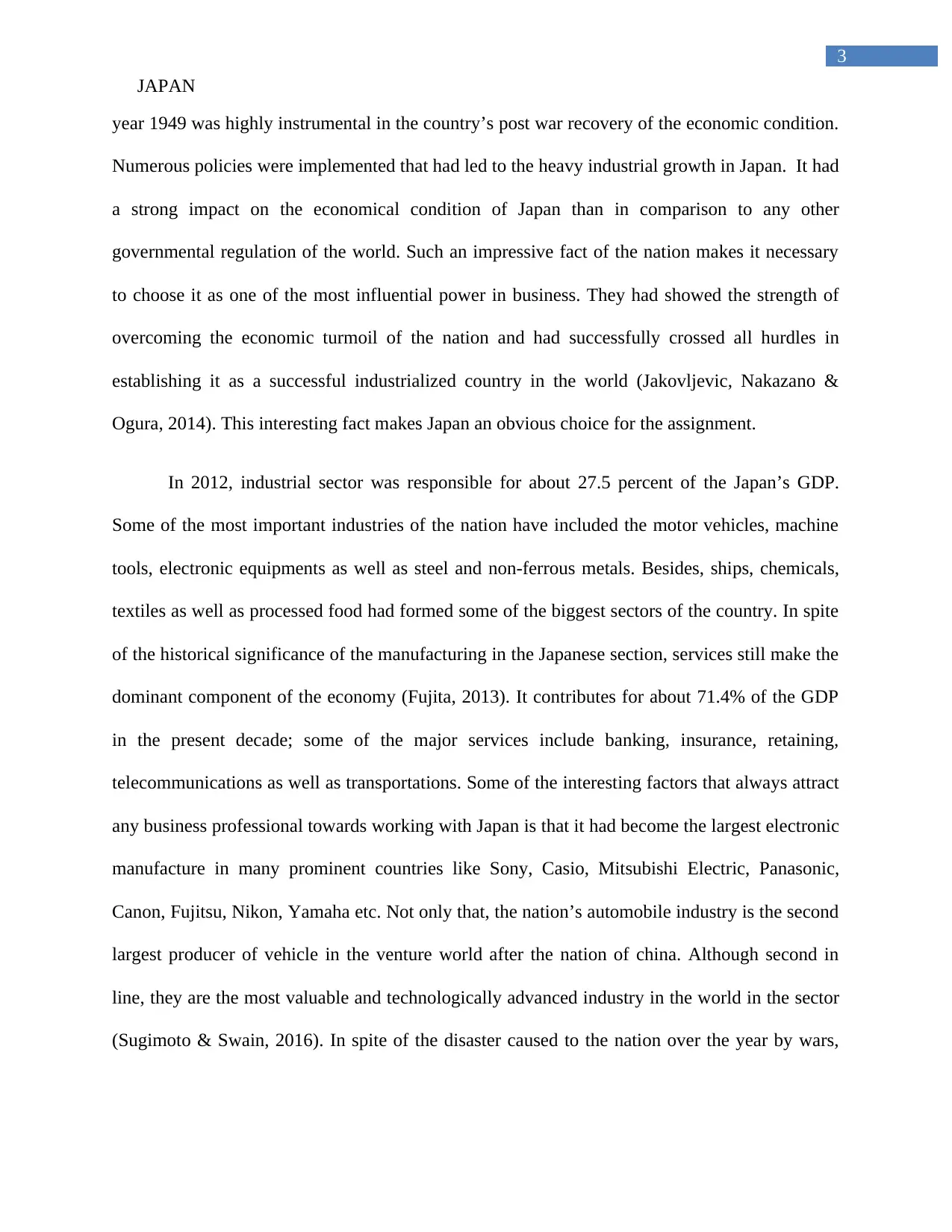
3
JAPAN
year 1949 was highly instrumental in the country’s post war recovery of the economic condition.
Numerous policies were implemented that had led to the heavy industrial growth in Japan. It had
a strong impact on the economical condition of Japan than in comparison to any other
governmental regulation of the world. Such an impressive fact of the nation makes it necessary
to choose it as one of the most influential power in business. They had showed the strength of
overcoming the economic turmoil of the nation and had successfully crossed all hurdles in
establishing it as a successful industrialized country in the world (Jakovljevic, Nakazano &
Ogura, 2014). This interesting fact makes Japan an obvious choice for the assignment.
In 2012, industrial sector was responsible for about 27.5 percent of the Japan’s GDP.
Some of the most important industries of the nation have included the motor vehicles, machine
tools, electronic equipments as well as steel and non-ferrous metals. Besides, ships, chemicals,
textiles as well as processed food had formed some of the biggest sectors of the country. In spite
of the historical significance of the manufacturing in the Japanese section, services still make the
dominant component of the economy (Fujita, 2013). It contributes for about 71.4% of the GDP
in the present decade; some of the major services include banking, insurance, retaining,
telecommunications as well as transportations. Some of the interesting factors that always attract
any business professional towards working with Japan is that it had become the largest electronic
manufacture in many prominent countries like Sony, Casio, Mitsubishi Electric, Panasonic,
Canon, Fujitsu, Nikon, Yamaha etc. Not only that, the nation’s automobile industry is the second
largest producer of vehicle in the venture world after the nation of china. Although second in
line, they are the most valuable and technologically advanced industry in the world in the sector
(Sugimoto & Swain, 2016). In spite of the disaster caused to the nation over the year by wars,
JAPAN
year 1949 was highly instrumental in the country’s post war recovery of the economic condition.
Numerous policies were implemented that had led to the heavy industrial growth in Japan. It had
a strong impact on the economical condition of Japan than in comparison to any other
governmental regulation of the world. Such an impressive fact of the nation makes it necessary
to choose it as one of the most influential power in business. They had showed the strength of
overcoming the economic turmoil of the nation and had successfully crossed all hurdles in
establishing it as a successful industrialized country in the world (Jakovljevic, Nakazano &
Ogura, 2014). This interesting fact makes Japan an obvious choice for the assignment.
In 2012, industrial sector was responsible for about 27.5 percent of the Japan’s GDP.
Some of the most important industries of the nation have included the motor vehicles, machine
tools, electronic equipments as well as steel and non-ferrous metals. Besides, ships, chemicals,
textiles as well as processed food had formed some of the biggest sectors of the country. In spite
of the historical significance of the manufacturing in the Japanese section, services still make the
dominant component of the economy (Fujita, 2013). It contributes for about 71.4% of the GDP
in the present decade; some of the major services include banking, insurance, retaining,
telecommunications as well as transportations. Some of the interesting factors that always attract
any business professional towards working with Japan is that it had become the largest electronic
manufacture in many prominent countries like Sony, Casio, Mitsubishi Electric, Panasonic,
Canon, Fujitsu, Nikon, Yamaha etc. Not only that, the nation’s automobile industry is the second
largest producer of vehicle in the venture world after the nation of china. Although second in
line, they are the most valuable and technologically advanced industry in the world in the sector
(Sugimoto & Swain, 2016). In spite of the disaster caused to the nation over the year by wars,
⊘ This is a preview!⊘
Do you want full access?
Subscribe today to unlock all pages.

Trusted by 1+ million students worldwide
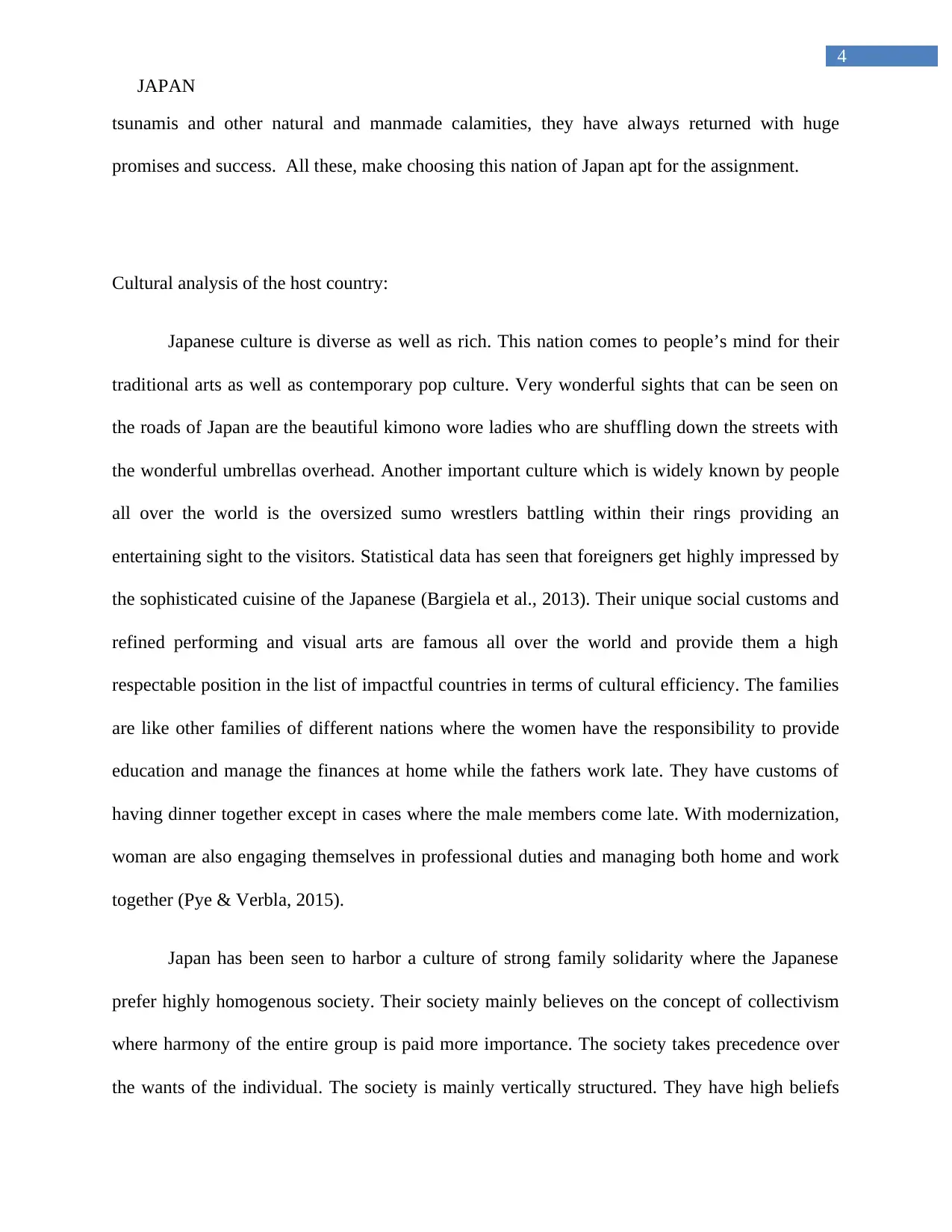
4
JAPAN
tsunamis and other natural and manmade calamities, they have always returned with huge
promises and success. All these, make choosing this nation of Japan apt for the assignment.
Cultural analysis of the host country:
Japanese culture is diverse as well as rich. This nation comes to people’s mind for their
traditional arts as well as contemporary pop culture. Very wonderful sights that can be seen on
the roads of Japan are the beautiful kimono wore ladies who are shuffling down the streets with
the wonderful umbrellas overhead. Another important culture which is widely known by people
all over the world is the oversized sumo wrestlers battling within their rings providing an
entertaining sight to the visitors. Statistical data has seen that foreigners get highly impressed by
the sophisticated cuisine of the Japanese (Bargiela et al., 2013). Their unique social customs and
refined performing and visual arts are famous all over the world and provide them a high
respectable position in the list of impactful countries in terms of cultural efficiency. The families
are like other families of different nations where the women have the responsibility to provide
education and manage the finances at home while the fathers work late. They have customs of
having dinner together except in cases where the male members come late. With modernization,
woman are also engaging themselves in professional duties and managing both home and work
together (Pye & Verbla, 2015).
Japan has been seen to harbor a culture of strong family solidarity where the Japanese
prefer highly homogenous society. Their society mainly believes on the concept of collectivism
where harmony of the entire group is paid more importance. The society takes precedence over
the wants of the individual. The society is mainly vertically structured. They have high beliefs
JAPAN
tsunamis and other natural and manmade calamities, they have always returned with huge
promises and success. All these, make choosing this nation of Japan apt for the assignment.
Cultural analysis of the host country:
Japanese culture is diverse as well as rich. This nation comes to people’s mind for their
traditional arts as well as contemporary pop culture. Very wonderful sights that can be seen on
the roads of Japan are the beautiful kimono wore ladies who are shuffling down the streets with
the wonderful umbrellas overhead. Another important culture which is widely known by people
all over the world is the oversized sumo wrestlers battling within their rings providing an
entertaining sight to the visitors. Statistical data has seen that foreigners get highly impressed by
the sophisticated cuisine of the Japanese (Bargiela et al., 2013). Their unique social customs and
refined performing and visual arts are famous all over the world and provide them a high
respectable position in the list of impactful countries in terms of cultural efficiency. The families
are like other families of different nations where the women have the responsibility to provide
education and manage the finances at home while the fathers work late. They have customs of
having dinner together except in cases where the male members come late. With modernization,
woman are also engaging themselves in professional duties and managing both home and work
together (Pye & Verbla, 2015).
Japan has been seen to harbor a culture of strong family solidarity where the Japanese
prefer highly homogenous society. Their society mainly believes on the concept of collectivism
where harmony of the entire group is paid more importance. The society takes precedence over
the wants of the individual. The society is mainly vertically structured. They have high beliefs
Paraphrase This Document
Need a fresh take? Get an instant paraphrase of this document with our AI Paraphraser
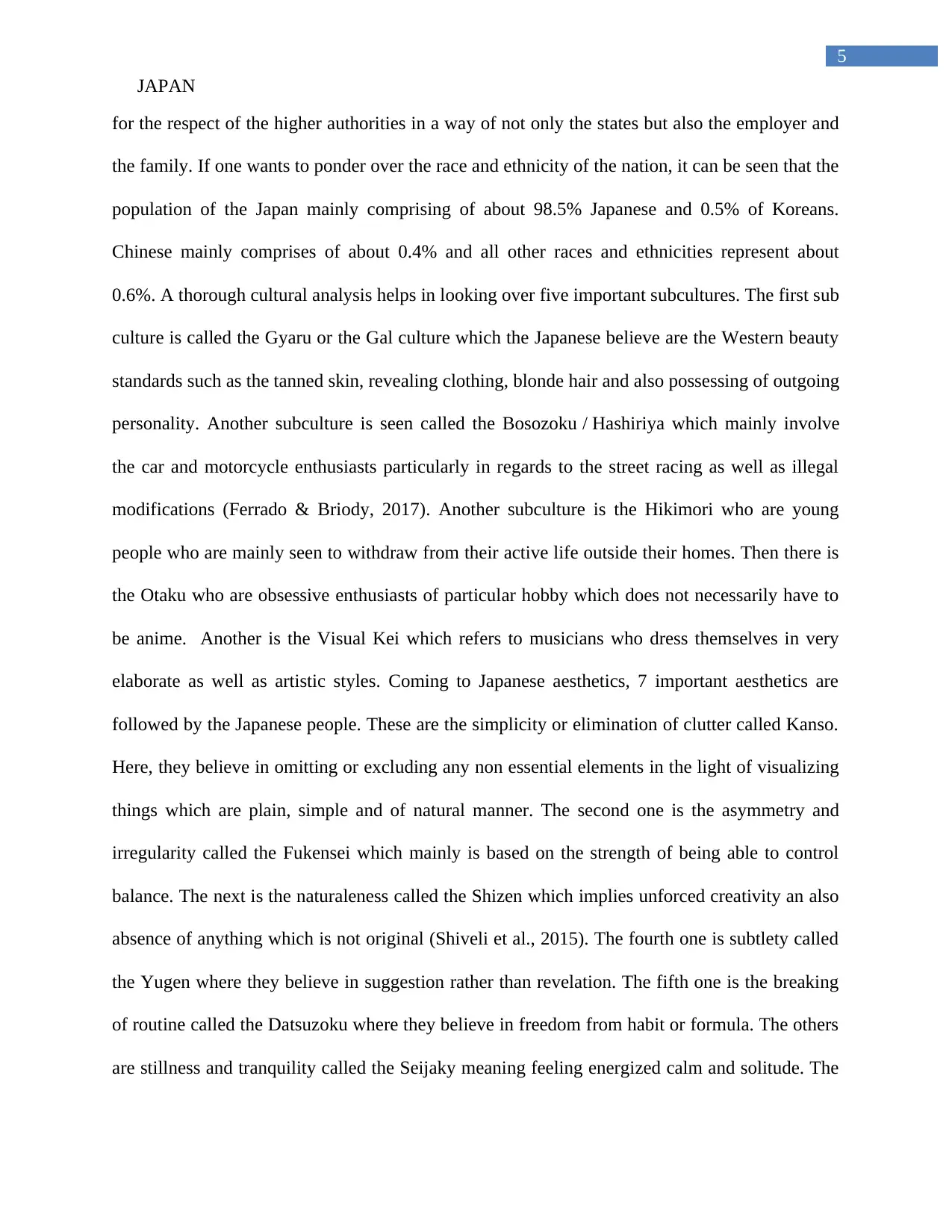
5
JAPAN
for the respect of the higher authorities in a way of not only the states but also the employer and
the family. If one wants to ponder over the race and ethnicity of the nation, it can be seen that the
population of the Japan mainly comprising of about 98.5% Japanese and 0.5% of Koreans.
Chinese mainly comprises of about 0.4% and all other races and ethnicities represent about
0.6%. A thorough cultural analysis helps in looking over five important subcultures. The first sub
culture is called the Gyaru or the Gal culture which the Japanese believe are the Western beauty
standards such as the tanned skin, revealing clothing, blonde hair and also possessing of outgoing
personality. Another subculture is seen called the Bosozoku / Hashiriya which mainly involve
the car and motorcycle enthusiasts particularly in regards to the street racing as well as illegal
modifications (Ferrado & Briody, 2017). Another subculture is the Hikimori who are young
people who are mainly seen to withdraw from their active life outside their homes. Then there is
the Otaku who are obsessive enthusiasts of particular hobby which does not necessarily have to
be anime. Another is the Visual Kei which refers to musicians who dress themselves in very
elaborate as well as artistic styles. Coming to Japanese aesthetics, 7 important aesthetics are
followed by the Japanese people. These are the simplicity or elimination of clutter called Kanso.
Here, they believe in omitting or excluding any non essential elements in the light of visualizing
things which are plain, simple and of natural manner. The second one is the asymmetry and
irregularity called the Fukensei which mainly is based on the strength of being able to control
balance. The next is the naturaleness called the Shizen which implies unforced creativity an also
absence of anything which is not original (Shiveli et al., 2015). The fourth one is subtlety called
the Yugen where they believe in suggestion rather than revelation. The fifth one is the breaking
of routine called the Datsuzoku where they believe in freedom from habit or formula. The others
are stillness and tranquility called the Seijaky meaning feeling energized calm and solitude. The
JAPAN
for the respect of the higher authorities in a way of not only the states but also the employer and
the family. If one wants to ponder over the race and ethnicity of the nation, it can be seen that the
population of the Japan mainly comprising of about 98.5% Japanese and 0.5% of Koreans.
Chinese mainly comprises of about 0.4% and all other races and ethnicities represent about
0.6%. A thorough cultural analysis helps in looking over five important subcultures. The first sub
culture is called the Gyaru or the Gal culture which the Japanese believe are the Western beauty
standards such as the tanned skin, revealing clothing, blonde hair and also possessing of outgoing
personality. Another subculture is seen called the Bosozoku / Hashiriya which mainly involve
the car and motorcycle enthusiasts particularly in regards to the street racing as well as illegal
modifications (Ferrado & Briody, 2017). Another subculture is the Hikimori who are young
people who are mainly seen to withdraw from their active life outside their homes. Then there is
the Otaku who are obsessive enthusiasts of particular hobby which does not necessarily have to
be anime. Another is the Visual Kei which refers to musicians who dress themselves in very
elaborate as well as artistic styles. Coming to Japanese aesthetics, 7 important aesthetics are
followed by the Japanese people. These are the simplicity or elimination of clutter called Kanso.
Here, they believe in omitting or excluding any non essential elements in the light of visualizing
things which are plain, simple and of natural manner. The second one is the asymmetry and
irregularity called the Fukensei which mainly is based on the strength of being able to control
balance. The next is the naturaleness called the Shizen which implies unforced creativity an also
absence of anything which is not original (Shiveli et al., 2015). The fourth one is subtlety called
the Yugen where they believe in suggestion rather than revelation. The fifth one is the breaking
of routine called the Datsuzoku where they believe in freedom from habit or formula. The others
are stillness and tranquility called the Seijaky meaning feeling energized calm and solitude. The
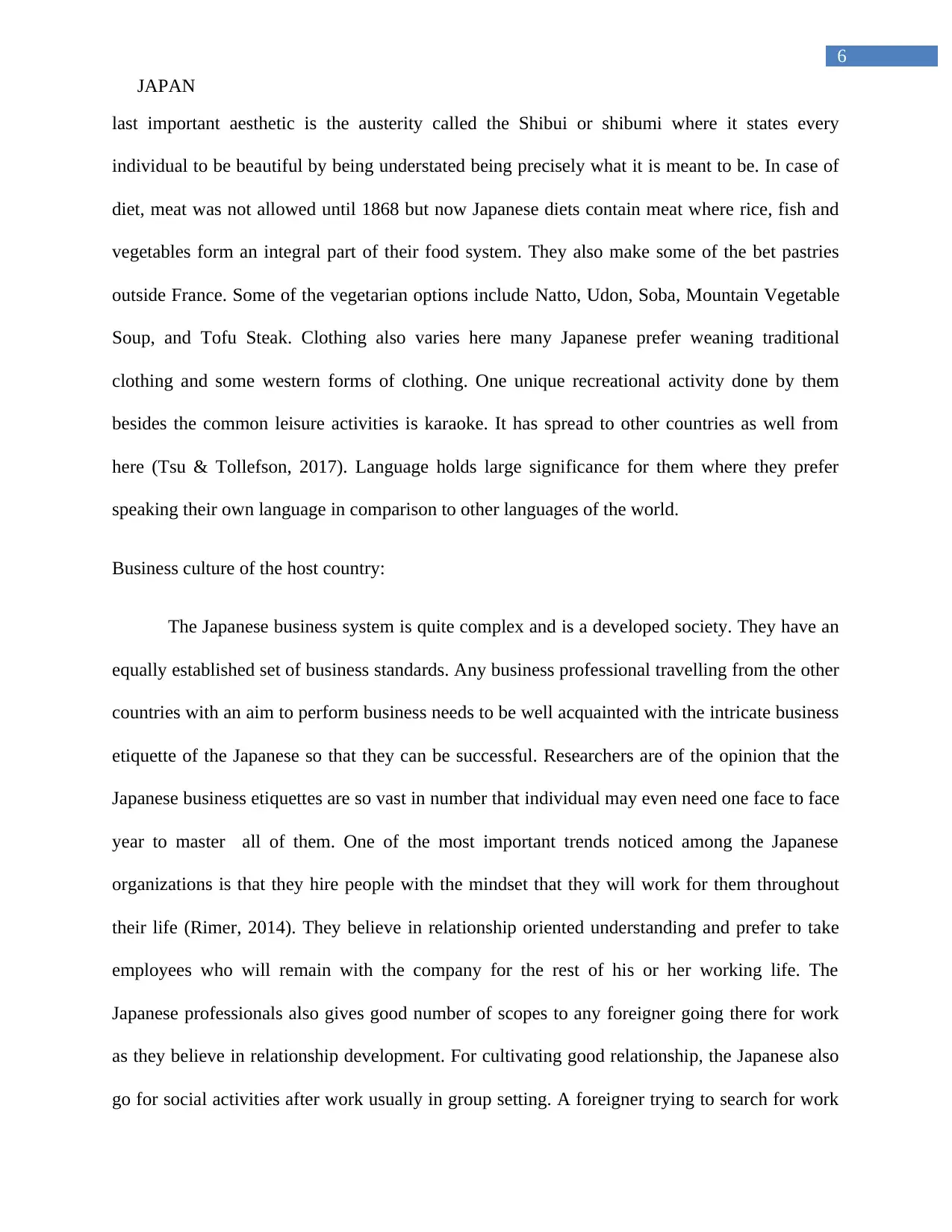
6
JAPAN
last important aesthetic is the austerity called the Shibui or shibumi where it states every
individual to be beautiful by being understated being precisely what it is meant to be. In case of
diet, meat was not allowed until 1868 but now Japanese diets contain meat where rice, fish and
vegetables form an integral part of their food system. They also make some of the bet pastries
outside France. Some of the vegetarian options include Natto, Udon, Soba, Mountain Vegetable
Soup, and Tofu Steak. Clothing also varies here many Japanese prefer weaning traditional
clothing and some western forms of clothing. One unique recreational activity done by them
besides the common leisure activities is karaoke. It has spread to other countries as well from
here (Tsu & Tollefson, 2017). Language holds large significance for them where they prefer
speaking their own language in comparison to other languages of the world.
Business culture of the host country:
The Japanese business system is quite complex and is a developed society. They have an
equally established set of business standards. Any business professional travelling from the other
countries with an aim to perform business needs to be well acquainted with the intricate business
etiquette of the Japanese so that they can be successful. Researchers are of the opinion that the
Japanese business etiquettes are so vast in number that individual may even need one face to face
year to master all of them. One of the most important trends noticed among the Japanese
organizations is that they hire people with the mindset that they will work for them throughout
their life (Rimer, 2014). They believe in relationship oriented understanding and prefer to take
employees who will remain with the company for the rest of his or her working life. The
Japanese professionals also gives good number of scopes to any foreigner going there for work
as they believe in relationship development. For cultivating good relationship, the Japanese also
go for social activities after work usually in group setting. A foreigner trying to search for work
JAPAN
last important aesthetic is the austerity called the Shibui or shibumi where it states every
individual to be beautiful by being understated being precisely what it is meant to be. In case of
diet, meat was not allowed until 1868 but now Japanese diets contain meat where rice, fish and
vegetables form an integral part of their food system. They also make some of the bet pastries
outside France. Some of the vegetarian options include Natto, Udon, Soba, Mountain Vegetable
Soup, and Tofu Steak. Clothing also varies here many Japanese prefer weaning traditional
clothing and some western forms of clothing. One unique recreational activity done by them
besides the common leisure activities is karaoke. It has spread to other countries as well from
here (Tsu & Tollefson, 2017). Language holds large significance for them where they prefer
speaking their own language in comparison to other languages of the world.
Business culture of the host country:
The Japanese business system is quite complex and is a developed society. They have an
equally established set of business standards. Any business professional travelling from the other
countries with an aim to perform business needs to be well acquainted with the intricate business
etiquette of the Japanese so that they can be successful. Researchers are of the opinion that the
Japanese business etiquettes are so vast in number that individual may even need one face to face
year to master all of them. One of the most important trends noticed among the Japanese
organizations is that they hire people with the mindset that they will work for them throughout
their life (Rimer, 2014). They believe in relationship oriented understanding and prefer to take
employees who will remain with the company for the rest of his or her working life. The
Japanese professionals also gives good number of scopes to any foreigner going there for work
as they believe in relationship development. For cultivating good relationship, the Japanese also
go for social activities after work usually in group setting. A foreigner trying to search for work
⊘ This is a preview!⊘
Do you want full access?
Subscribe today to unlock all pages.

Trusted by 1+ million students worldwide
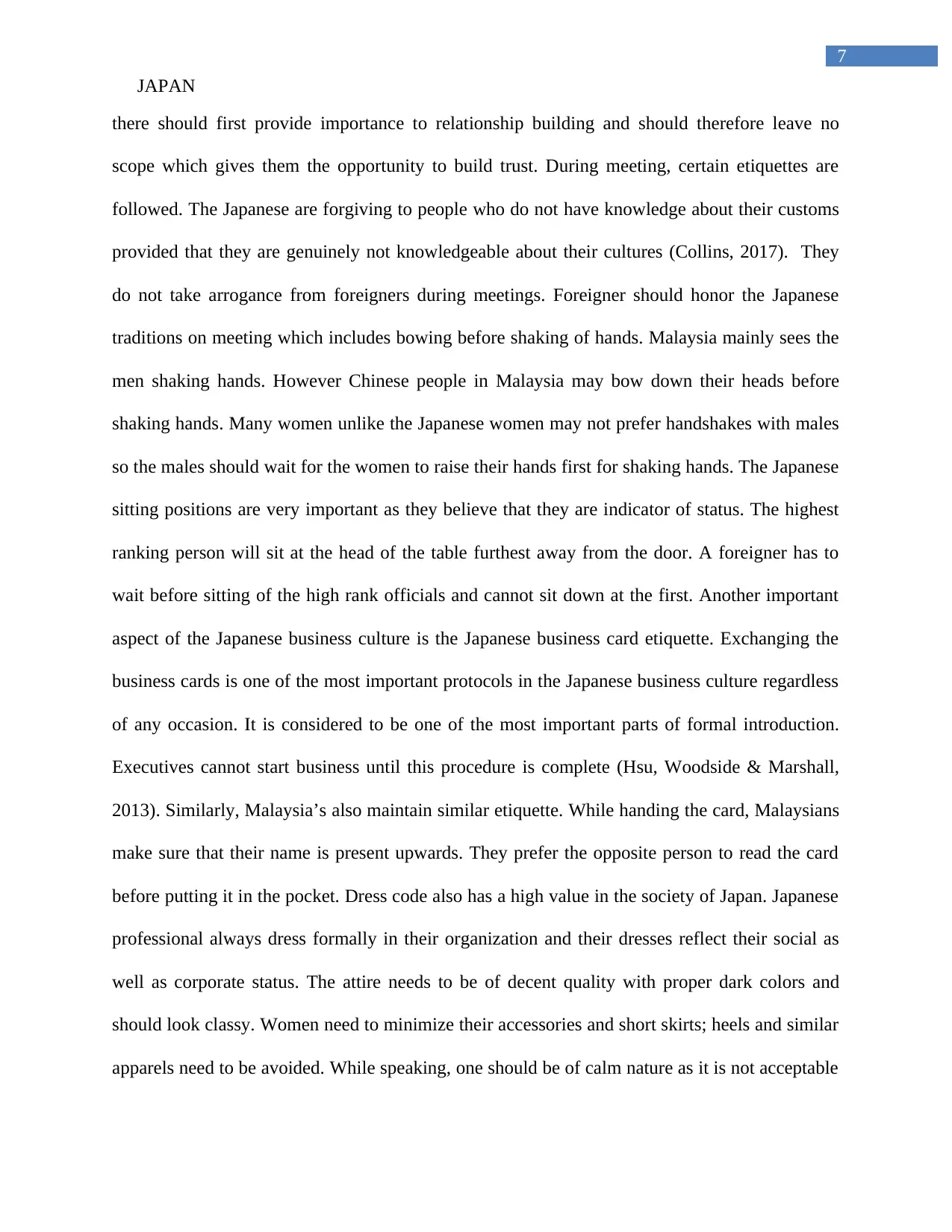
7
JAPAN
there should first provide importance to relationship building and should therefore leave no
scope which gives them the opportunity to build trust. During meeting, certain etiquettes are
followed. The Japanese are forgiving to people who do not have knowledge about their customs
provided that they are genuinely not knowledgeable about their cultures (Collins, 2017). They
do not take arrogance from foreigners during meetings. Foreigner should honor the Japanese
traditions on meeting which includes bowing before shaking of hands. Malaysia mainly sees the
men shaking hands. However Chinese people in Malaysia may bow down their heads before
shaking hands. Many women unlike the Japanese women may not prefer handshakes with males
so the males should wait for the women to raise their hands first for shaking hands. The Japanese
sitting positions are very important as they believe that they are indicator of status. The highest
ranking person will sit at the head of the table furthest away from the door. A foreigner has to
wait before sitting of the high rank officials and cannot sit down at the first. Another important
aspect of the Japanese business culture is the Japanese business card etiquette. Exchanging the
business cards is one of the most important protocols in the Japanese business culture regardless
of any occasion. It is considered to be one of the most important parts of formal introduction.
Executives cannot start business until this procedure is complete (Hsu, Woodside & Marshall,
2013). Similarly, Malaysia’s also maintain similar etiquette. While handing the card, Malaysians
make sure that their name is present upwards. They prefer the opposite person to read the card
before putting it in the pocket. Dress code also has a high value in the society of Japan. Japanese
professional always dress formally in their organization and their dresses reflect their social as
well as corporate status. The attire needs to be of decent quality with proper dark colors and
should look classy. Women need to minimize their accessories and short skirts; heels and similar
apparels need to be avoided. While speaking, one should be of calm nature as it is not acceptable
JAPAN
there should first provide importance to relationship building and should therefore leave no
scope which gives them the opportunity to build trust. During meeting, certain etiquettes are
followed. The Japanese are forgiving to people who do not have knowledge about their customs
provided that they are genuinely not knowledgeable about their cultures (Collins, 2017). They
do not take arrogance from foreigners during meetings. Foreigner should honor the Japanese
traditions on meeting which includes bowing before shaking of hands. Malaysia mainly sees the
men shaking hands. However Chinese people in Malaysia may bow down their heads before
shaking hands. Many women unlike the Japanese women may not prefer handshakes with males
so the males should wait for the women to raise their hands first for shaking hands. The Japanese
sitting positions are very important as they believe that they are indicator of status. The highest
ranking person will sit at the head of the table furthest away from the door. A foreigner has to
wait before sitting of the high rank officials and cannot sit down at the first. Another important
aspect of the Japanese business culture is the Japanese business card etiquette. Exchanging the
business cards is one of the most important protocols in the Japanese business culture regardless
of any occasion. It is considered to be one of the most important parts of formal introduction.
Executives cannot start business until this procedure is complete (Hsu, Woodside & Marshall,
2013). Similarly, Malaysia’s also maintain similar etiquette. While handing the card, Malaysians
make sure that their name is present upwards. They prefer the opposite person to read the card
before putting it in the pocket. Dress code also has a high value in the society of Japan. Japanese
professional always dress formally in their organization and their dresses reflect their social as
well as corporate status. The attire needs to be of decent quality with proper dark colors and
should look classy. Women need to minimize their accessories and short skirts; heels and similar
apparels need to be avoided. While speaking, one should be of calm nature as it is not acceptable
Paraphrase This Document
Need a fresh take? Get an instant paraphrase of this document with our AI Paraphraser
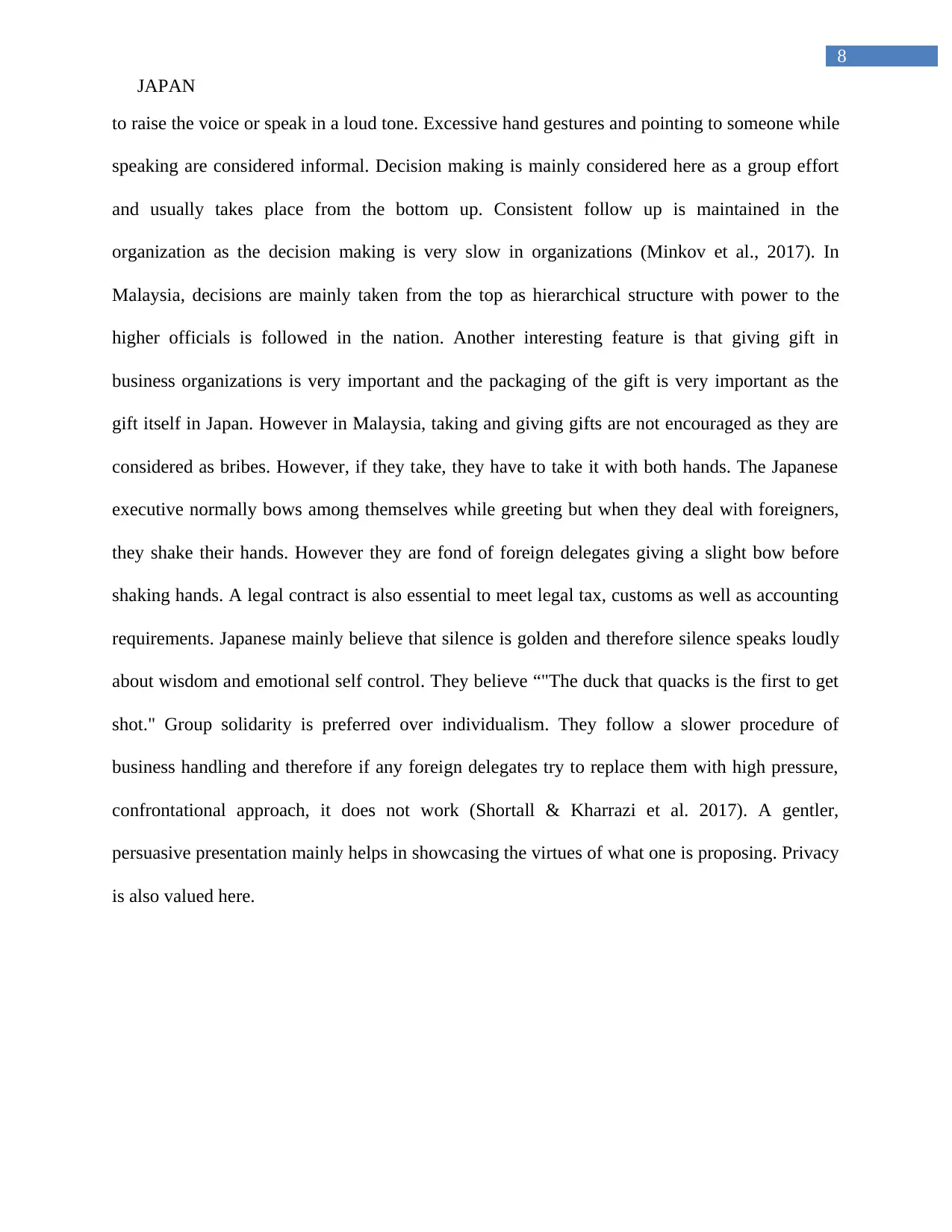
8
JAPAN
to raise the voice or speak in a loud tone. Excessive hand gestures and pointing to someone while
speaking are considered informal. Decision making is mainly considered here as a group effort
and usually takes place from the bottom up. Consistent follow up is maintained in the
organization as the decision making is very slow in organizations (Minkov et al., 2017). In
Malaysia, decisions are mainly taken from the top as hierarchical structure with power to the
higher officials is followed in the nation. Another interesting feature is that giving gift in
business organizations is very important and the packaging of the gift is very important as the
gift itself in Japan. However in Malaysia, taking and giving gifts are not encouraged as they are
considered as bribes. However, if they take, they have to take it with both hands. The Japanese
executive normally bows among themselves while greeting but when they deal with foreigners,
they shake their hands. However they are fond of foreign delegates giving a slight bow before
shaking hands. A legal contract is also essential to meet legal tax, customs as well as accounting
requirements. Japanese mainly believe that silence is golden and therefore silence speaks loudly
about wisdom and emotional self control. They believe “"The duck that quacks is the first to get
shot." Group solidarity is preferred over individualism. They follow a slower procedure of
business handling and therefore if any foreign delegates try to replace them with high pressure,
confrontational approach, it does not work (Shortall & Kharrazi et al. 2017). A gentler,
persuasive presentation mainly helps in showcasing the virtues of what one is proposing. Privacy
is also valued here.
JAPAN
to raise the voice or speak in a loud tone. Excessive hand gestures and pointing to someone while
speaking are considered informal. Decision making is mainly considered here as a group effort
and usually takes place from the bottom up. Consistent follow up is maintained in the
organization as the decision making is very slow in organizations (Minkov et al., 2017). In
Malaysia, decisions are mainly taken from the top as hierarchical structure with power to the
higher officials is followed in the nation. Another interesting feature is that giving gift in
business organizations is very important and the packaging of the gift is very important as the
gift itself in Japan. However in Malaysia, taking and giving gifts are not encouraged as they are
considered as bribes. However, if they take, they have to take it with both hands. The Japanese
executive normally bows among themselves while greeting but when they deal with foreigners,
they shake their hands. However they are fond of foreign delegates giving a slight bow before
shaking hands. A legal contract is also essential to meet legal tax, customs as well as accounting
requirements. Japanese mainly believe that silence is golden and therefore silence speaks loudly
about wisdom and emotional self control. They believe “"The duck that quacks is the first to get
shot." Group solidarity is preferred over individualism. They follow a slower procedure of
business handling and therefore if any foreign delegates try to replace them with high pressure,
confrontational approach, it does not work (Shortall & Kharrazi et al. 2017). A gentler,
persuasive presentation mainly helps in showcasing the virtues of what one is proposing. Privacy
is also valued here.
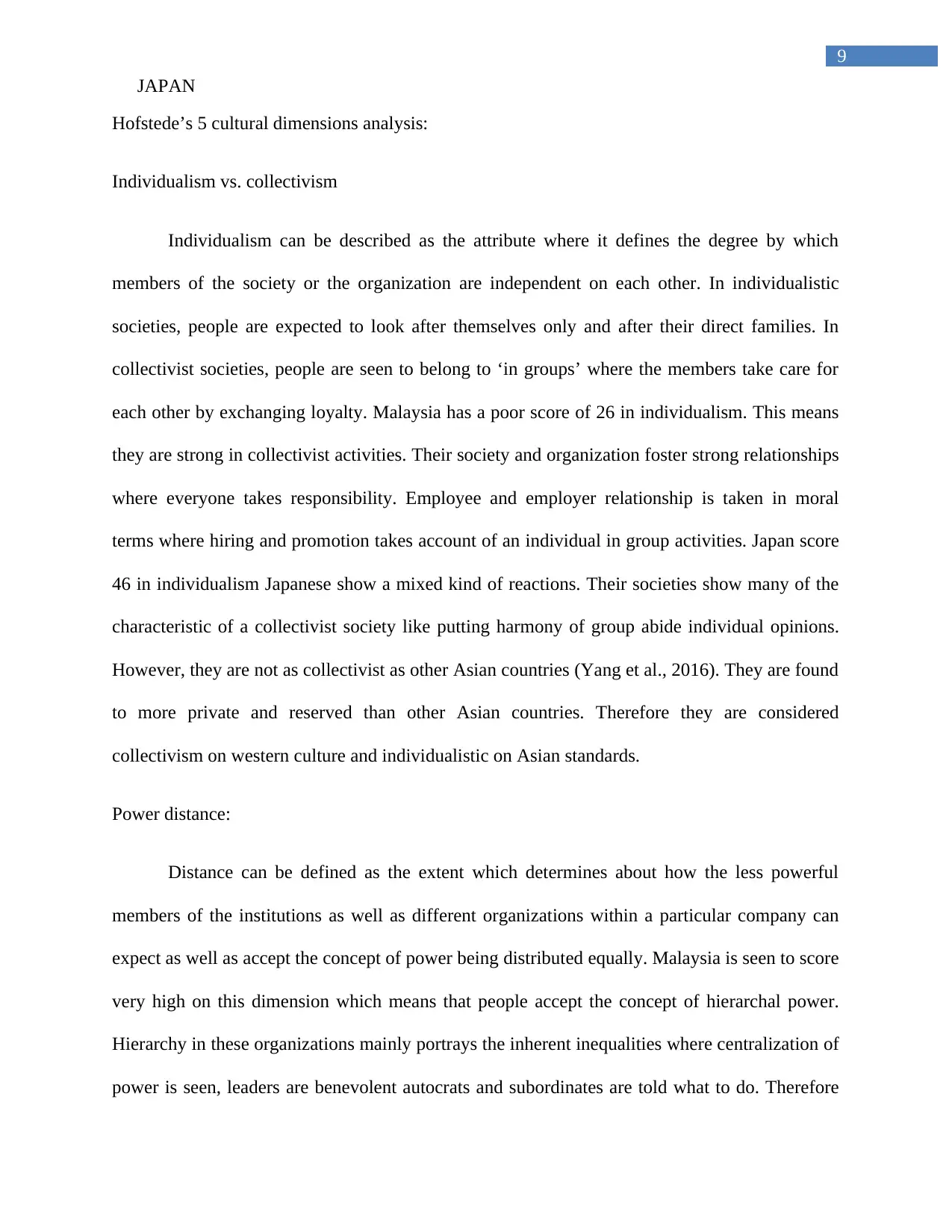
9
JAPAN
Hofstede’s 5 cultural dimensions analysis:
Individualism vs. collectivism
Individualism can be described as the attribute where it defines the degree by which
members of the society or the organization are independent on each other. In individualistic
societies, people are expected to look after themselves only and after their direct families. In
collectivist societies, people are seen to belong to ‘in groups’ where the members take care for
each other by exchanging loyalty. Malaysia has a poor score of 26 in individualism. This means
they are strong in collectivist activities. Their society and organization foster strong relationships
where everyone takes responsibility. Employee and employer relationship is taken in moral
terms where hiring and promotion takes account of an individual in group activities. Japan score
46 in individualism Japanese show a mixed kind of reactions. Their societies show many of the
characteristic of a collectivist society like putting harmony of group abide individual opinions.
However, they are not as collectivist as other Asian countries (Yang et al., 2016). They are found
to more private and reserved than other Asian countries. Therefore they are considered
collectivism on western culture and individualistic on Asian standards.
Power distance:
Distance can be defined as the extent which determines about how the less powerful
members of the institutions as well as different organizations within a particular company can
expect as well as accept the concept of power being distributed equally. Malaysia is seen to score
very high on this dimension which means that people accept the concept of hierarchal power.
Hierarchy in these organizations mainly portrays the inherent inequalities where centralization of
power is seen, leaders are benevolent autocrats and subordinates are told what to do. Therefore
JAPAN
Hofstede’s 5 cultural dimensions analysis:
Individualism vs. collectivism
Individualism can be described as the attribute where it defines the degree by which
members of the society or the organization are independent on each other. In individualistic
societies, people are expected to look after themselves only and after their direct families. In
collectivist societies, people are seen to belong to ‘in groups’ where the members take care for
each other by exchanging loyalty. Malaysia has a poor score of 26 in individualism. This means
they are strong in collectivist activities. Their society and organization foster strong relationships
where everyone takes responsibility. Employee and employer relationship is taken in moral
terms where hiring and promotion takes account of an individual in group activities. Japan score
46 in individualism Japanese show a mixed kind of reactions. Their societies show many of the
characteristic of a collectivist society like putting harmony of group abide individual opinions.
However, they are not as collectivist as other Asian countries (Yang et al., 2016). They are found
to more private and reserved than other Asian countries. Therefore they are considered
collectivism on western culture and individualistic on Asian standards.
Power distance:
Distance can be defined as the extent which determines about how the less powerful
members of the institutions as well as different organizations within a particular company can
expect as well as accept the concept of power being distributed equally. Malaysia is seen to score
very high on this dimension which means that people accept the concept of hierarchal power.
Hierarchy in these organizations mainly portrays the inherent inequalities where centralization of
power is seen, leaders are benevolent autocrats and subordinates are told what to do. Therefore
⊘ This is a preview!⊘
Do you want full access?
Subscribe today to unlock all pages.

Trusted by 1+ million students worldwide
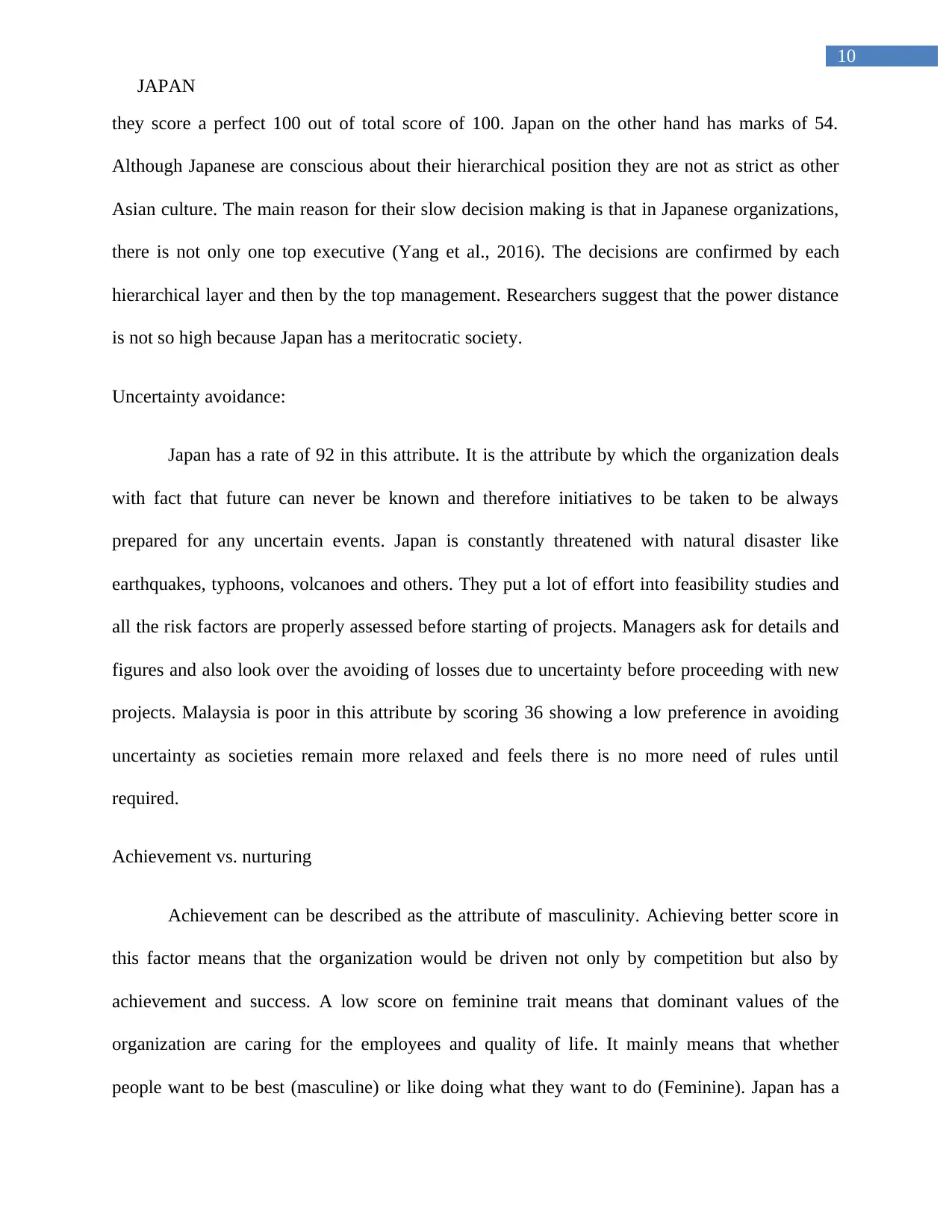
10
JAPAN
they score a perfect 100 out of total score of 100. Japan on the other hand has marks of 54.
Although Japanese are conscious about their hierarchical position they are not as strict as other
Asian culture. The main reason for their slow decision making is that in Japanese organizations,
there is not only one top executive (Yang et al., 2016). The decisions are confirmed by each
hierarchical layer and then by the top management. Researchers suggest that the power distance
is not so high because Japan has a meritocratic society.
Uncertainty avoidance:
Japan has a rate of 92 in this attribute. It is the attribute by which the organization deals
with fact that future can never be known and therefore initiatives to be taken to be always
prepared for any uncertain events. Japan is constantly threatened with natural disaster like
earthquakes, typhoons, volcanoes and others. They put a lot of effort into feasibility studies and
all the risk factors are properly assessed before starting of projects. Managers ask for details and
figures and also look over the avoiding of losses due to uncertainty before proceeding with new
projects. Malaysia is poor in this attribute by scoring 36 showing a low preference in avoiding
uncertainty as societies remain more relaxed and feels there is no more need of rules until
required.
Achievement vs. nurturing
Achievement can be described as the attribute of masculinity. Achieving better score in
this factor means that the organization would be driven not only by competition but also by
achievement and success. A low score on feminine trait means that dominant values of the
organization are caring for the employees and quality of life. It mainly means that whether
people want to be best (masculine) or like doing what they want to do (Feminine). Japan has a
JAPAN
they score a perfect 100 out of total score of 100. Japan on the other hand has marks of 54.
Although Japanese are conscious about their hierarchical position they are not as strict as other
Asian culture. The main reason for their slow decision making is that in Japanese organizations,
there is not only one top executive (Yang et al., 2016). The decisions are confirmed by each
hierarchical layer and then by the top management. Researchers suggest that the power distance
is not so high because Japan has a meritocratic society.
Uncertainty avoidance:
Japan has a rate of 92 in this attribute. It is the attribute by which the organization deals
with fact that future can never be known and therefore initiatives to be taken to be always
prepared for any uncertain events. Japan is constantly threatened with natural disaster like
earthquakes, typhoons, volcanoes and others. They put a lot of effort into feasibility studies and
all the risk factors are properly assessed before starting of projects. Managers ask for details and
figures and also look over the avoiding of losses due to uncertainty before proceeding with new
projects. Malaysia is poor in this attribute by scoring 36 showing a low preference in avoiding
uncertainty as societies remain more relaxed and feels there is no more need of rules until
required.
Achievement vs. nurturing
Achievement can be described as the attribute of masculinity. Achieving better score in
this factor means that the organization would be driven not only by competition but also by
achievement and success. A low score on feminine trait means that dominant values of the
organization are caring for the employees and quality of life. It mainly means that whether
people want to be best (masculine) or like doing what they want to do (Feminine). Japan has a
Paraphrase This Document
Need a fresh take? Get an instant paraphrase of this document with our AI Paraphraser
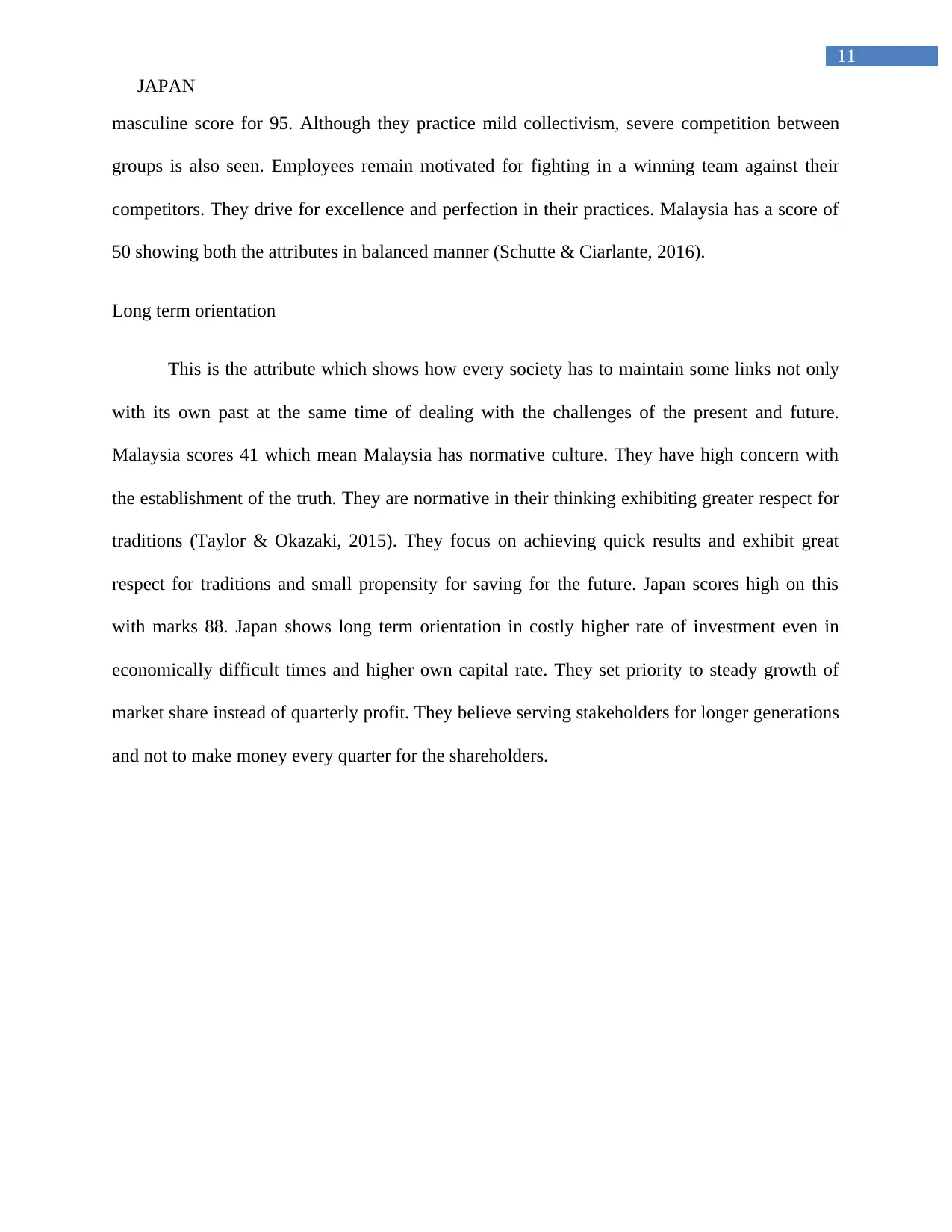
11
JAPAN
masculine score for 95. Although they practice mild collectivism, severe competition between
groups is also seen. Employees remain motivated for fighting in a winning team against their
competitors. They drive for excellence and perfection in their practices. Malaysia has a score of
50 showing both the attributes in balanced manner (Schutte & Ciarlante, 2016).
Long term orientation
This is the attribute which shows how every society has to maintain some links not only
with its own past at the same time of dealing with the challenges of the present and future.
Malaysia scores 41 which mean Malaysia has normative culture. They have high concern with
the establishment of the truth. They are normative in their thinking exhibiting greater respect for
traditions (Taylor & Okazaki, 2015). They focus on achieving quick results and exhibit great
respect for traditions and small propensity for saving for the future. Japan scores high on this
with marks 88. Japan shows long term orientation in costly higher rate of investment even in
economically difficult times and higher own capital rate. They set priority to steady growth of
market share instead of quarterly profit. They believe serving stakeholders for longer generations
and not to make money every quarter for the shareholders.
JAPAN
masculine score for 95. Although they practice mild collectivism, severe competition between
groups is also seen. Employees remain motivated for fighting in a winning team against their
competitors. They drive for excellence and perfection in their practices. Malaysia has a score of
50 showing both the attributes in balanced manner (Schutte & Ciarlante, 2016).
Long term orientation
This is the attribute which shows how every society has to maintain some links not only
with its own past at the same time of dealing with the challenges of the present and future.
Malaysia scores 41 which mean Malaysia has normative culture. They have high concern with
the establishment of the truth. They are normative in their thinking exhibiting greater respect for
traditions (Taylor & Okazaki, 2015). They focus on achieving quick results and exhibit great
respect for traditions and small propensity for saving for the future. Japan scores high on this
with marks 88. Japan shows long term orientation in costly higher rate of investment even in
economically difficult times and higher own capital rate. They set priority to steady growth of
market share instead of quarterly profit. They believe serving stakeholders for longer generations
and not to make money every quarter for the shareholders.
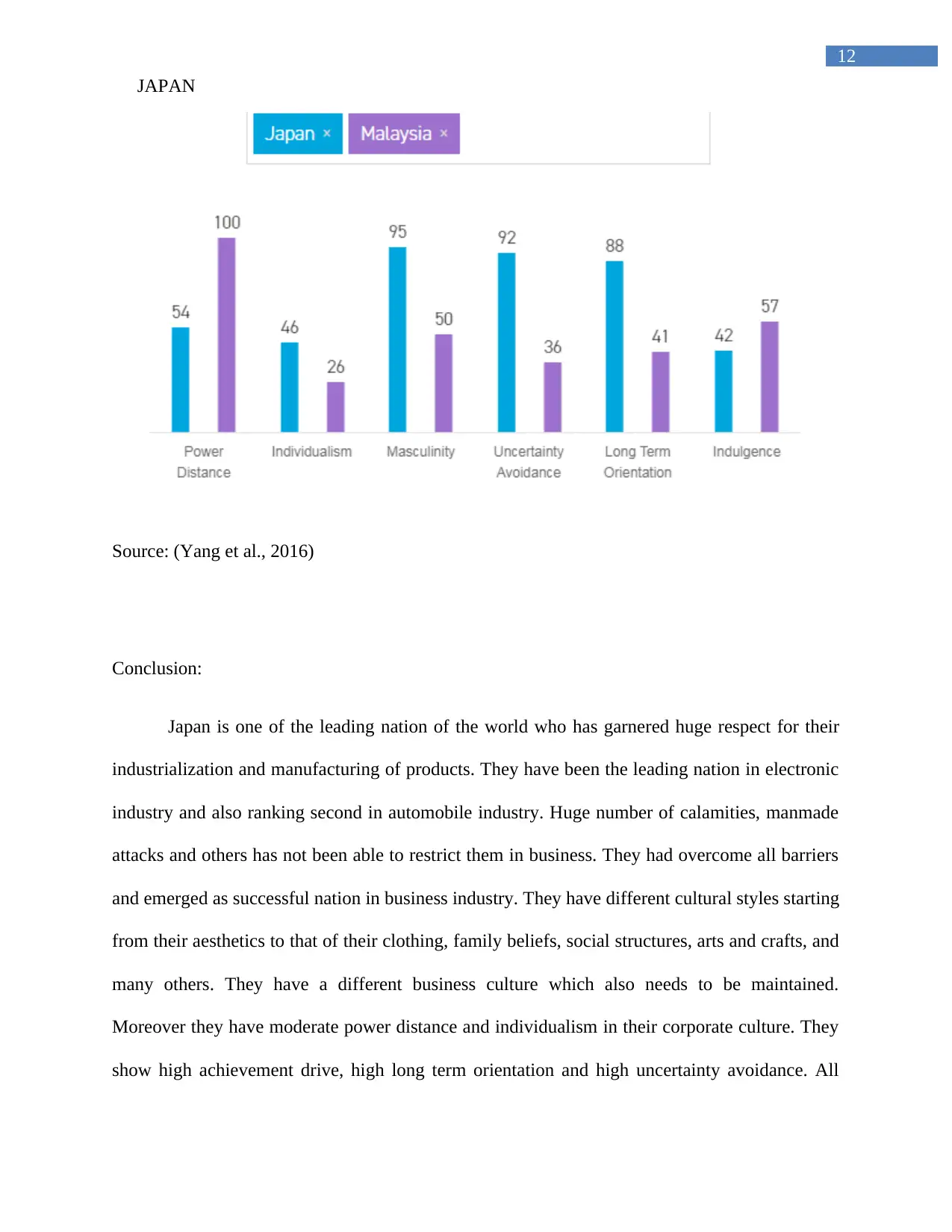
12
JAPAN
Source: (Yang et al., 2016)
Conclusion:
Japan is one of the leading nation of the world who has garnered huge respect for their
industrialization and manufacturing of products. They have been the leading nation in electronic
industry and also ranking second in automobile industry. Huge number of calamities, manmade
attacks and others has not been able to restrict them in business. They had overcome all barriers
and emerged as successful nation in business industry. They have different cultural styles starting
from their aesthetics to that of their clothing, family beliefs, social structures, arts and crafts, and
many others. They have a different business culture which also needs to be maintained.
Moreover they have moderate power distance and individualism in their corporate culture. They
show high achievement drive, high long term orientation and high uncertainty avoidance. All
JAPAN
Source: (Yang et al., 2016)
Conclusion:
Japan is one of the leading nation of the world who has garnered huge respect for their
industrialization and manufacturing of products. They have been the leading nation in electronic
industry and also ranking second in automobile industry. Huge number of calamities, manmade
attacks and others has not been able to restrict them in business. They had overcome all barriers
and emerged as successful nation in business industry. They have different cultural styles starting
from their aesthetics to that of their clothing, family beliefs, social structures, arts and crafts, and
many others. They have a different business culture which also needs to be maintained.
Moreover they have moderate power distance and individualism in their corporate culture. They
show high achievement drive, high long term orientation and high uncertainty avoidance. All
⊘ This is a preview!⊘
Do you want full access?
Subscribe today to unlock all pages.

Trusted by 1+ million students worldwide
1 out of 16
Related Documents
Your All-in-One AI-Powered Toolkit for Academic Success.
+13062052269
info@desklib.com
Available 24*7 on WhatsApp / Email
![[object Object]](/_next/static/media/star-bottom.7253800d.svg)
Unlock your academic potential
Copyright © 2020–2025 A2Z Services. All Rights Reserved. Developed and managed by ZUCOL.





